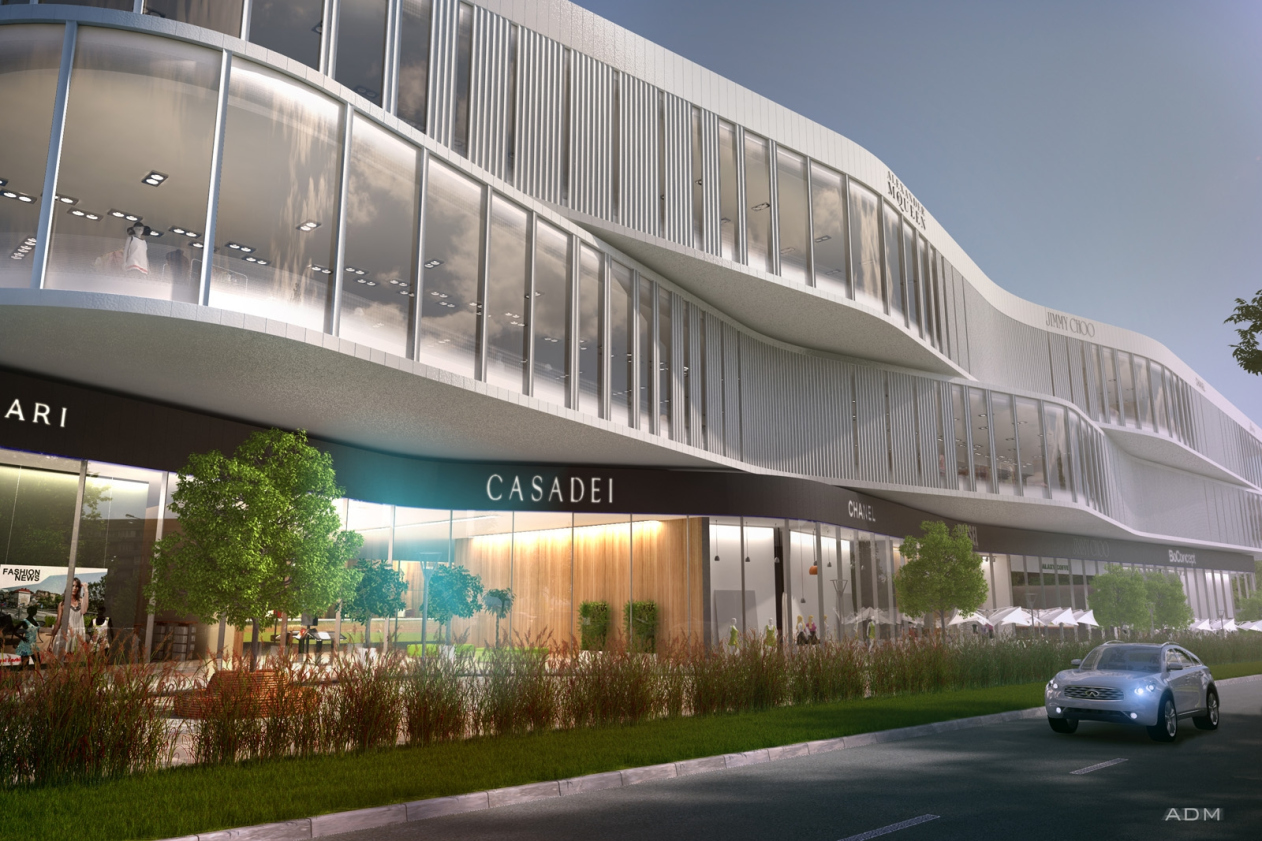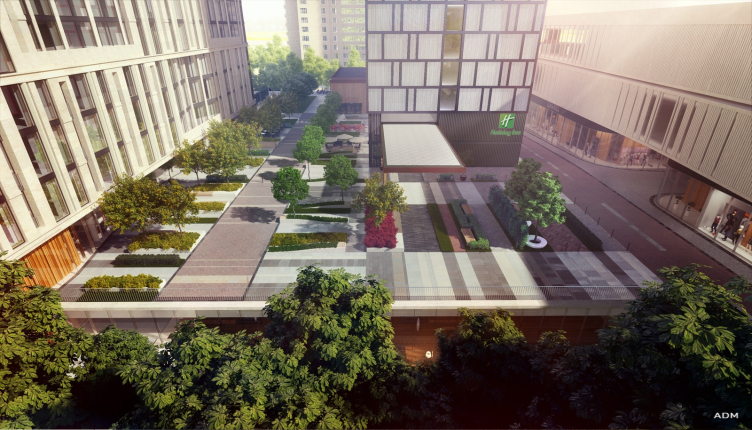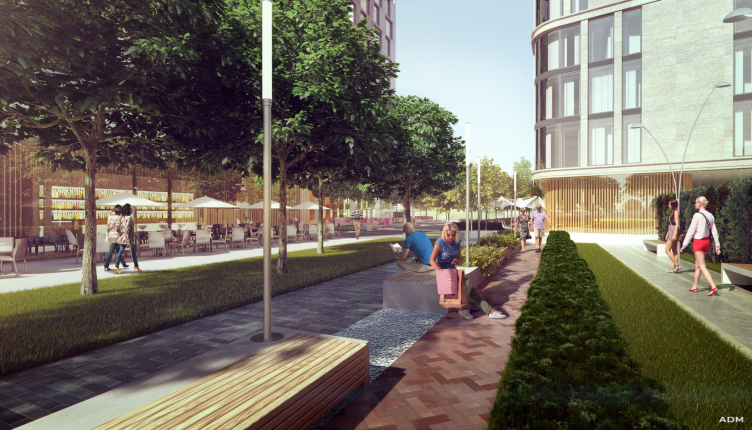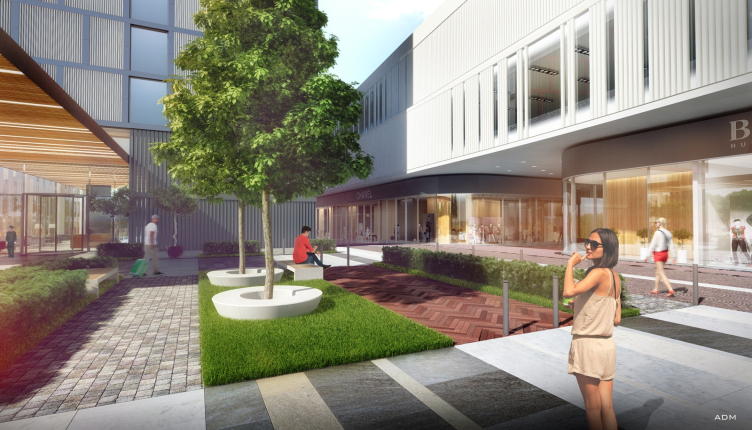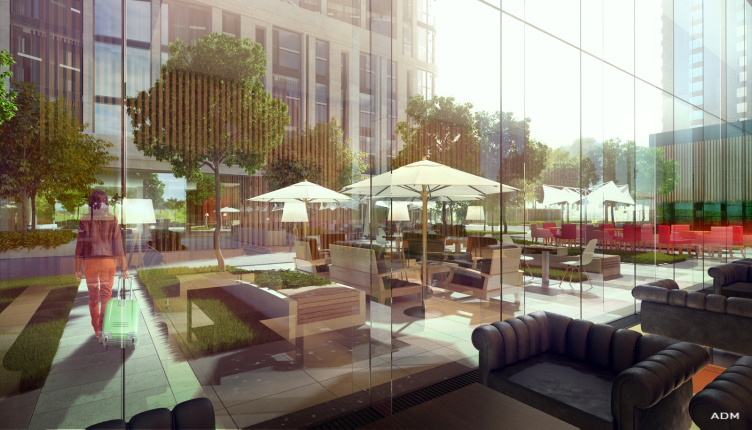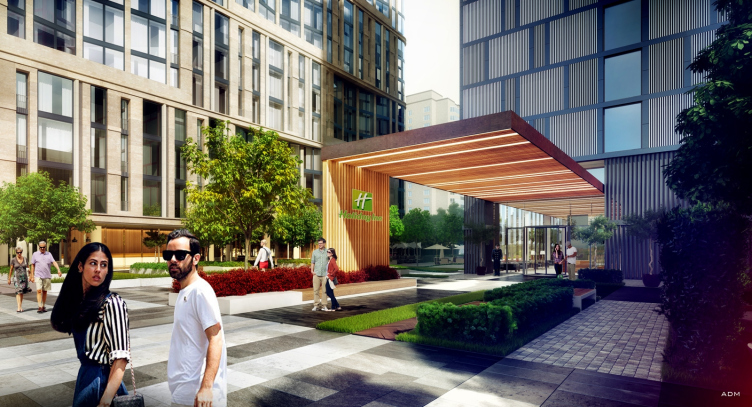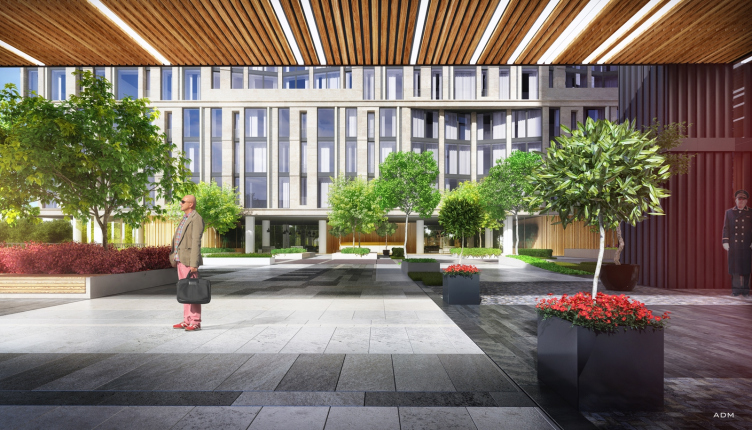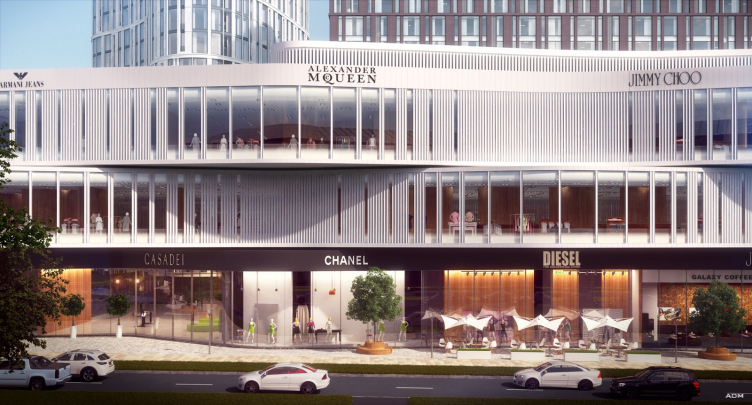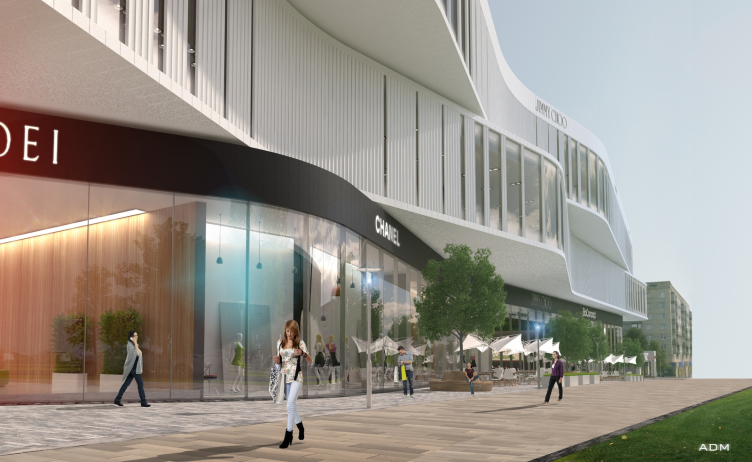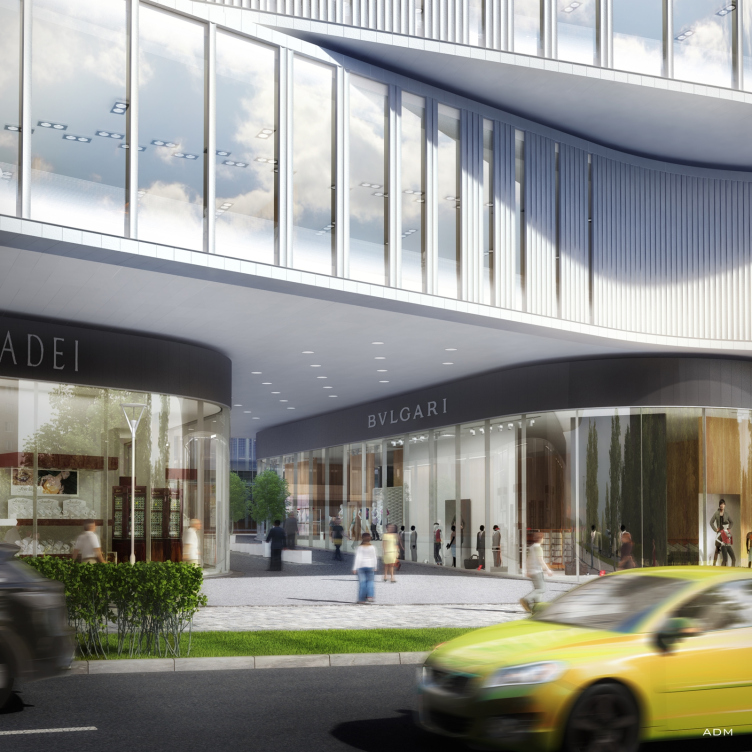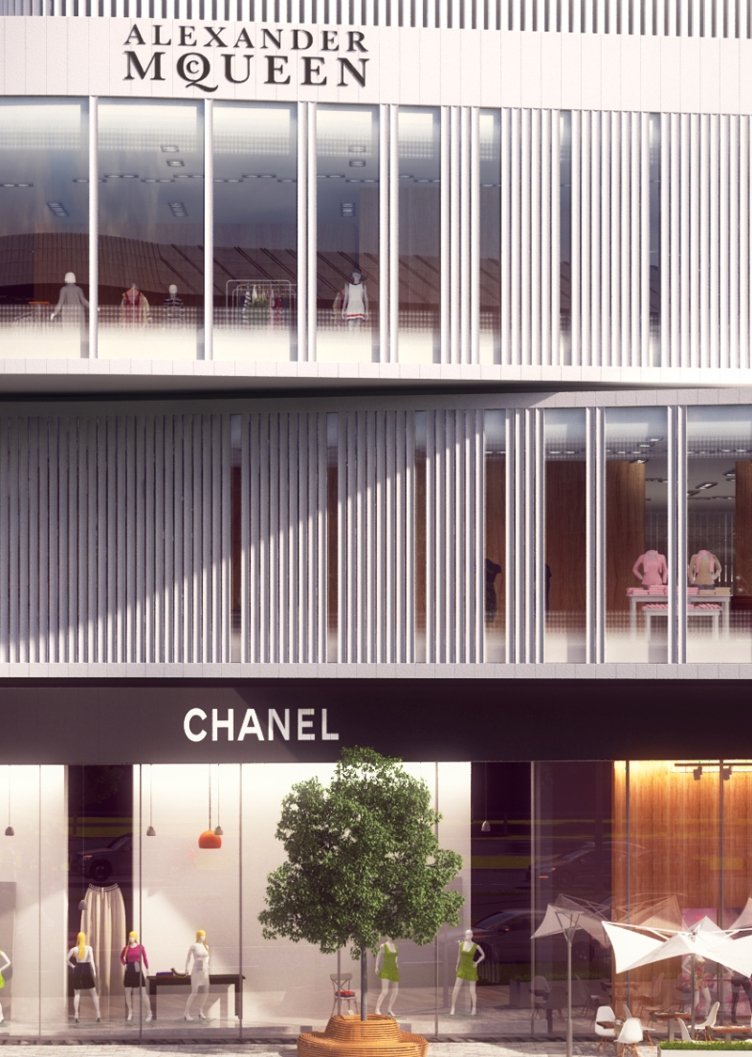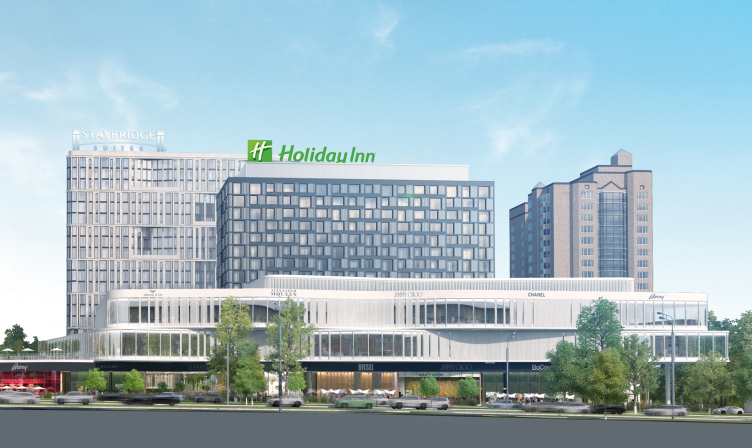The hotel stands on the hillock, stepping back from the highway of the avenue's relief road. In front of it, there is a lawn and a parking lot, on the left, western, side, there is a small park. At some distance, there is also a house of the Khrushchev time, and, to the right, nearly precisely next to the hotel, there is a tower built in the late nineties.
The ADM architects were faced with the task of reconstructing the hotel and adding yet another hotel and a shopping building to it - at the same time keeping the park intact. The architects placed the low-rise but at the same time elongated volume of the shopping center along the red line, thus supporting the front of the residential houses of the avenue. For the new building of the hotel, named Staybridge, a place was found in the third row, deeper inside the land plot, behind the slab of the remodeled "Sputnik" - that will be renamed into Holiday Inn.
The architects did keep the existing square intact. As for the territory between the shopping mall and the hotel buildings, however, it was turned into a well-organized city square with picturesque mosaic of diverse paving patterns, blue spruce trees, pavement-level green lawns, the though-out laconic street furniture and the umbrellas of the summer cafes - in a word, the architects carefully organized it, the way ADM does in its virtually project, growing around their buildings layers of so-unlike-Moscow comfortable and well-thought urban space. Meanwhile, the internal square is situated not at all on the ground level but on the roof of the facilities of the basement tier - the relief here gradually lowers three meters down from northwest to southeast, and the architects leveled the place out at the expense of sub-structures, getting a flat surface on the roof, and usable premises under the roof - the extra volume that stops short in the western part with a stark glass wall turned to the trees of the park. Behind the glass wall, there are conference halls.
Part of the design of the hotel square is the protruding marquee of the entrance group of the former "Sputnik" (now "Holiday Inn"): under this marquee, the taxis can await the hotel guests without the latter running the risk of getting wet in the rain. The wooden laths echo the design of the reception areas on the ground floors of both hotels and, alternating with the stripes of the lamps of the same configuration, look like piano keys. The lamps and the ceiling merge into one, and one starts wondering involuntarily - perhaps ALL the stripes are capable of glowing here? But - no! Wood is also important, and it is really abundant behind the transparent walls of the lower floors, giving the whole place - both outside and outside - a cozy countryside feel.
Besides the special features of the terrain, the architects were to take into consideration the close vicinity of a residential house. Looking to keep the insolation of its apartments as intact as possible, the architects cut diagonally the northeast corner of the trading center - which became the starting point - although not the sole reason - for its smooth, wave-shaped, and undulating sculptural shape. An impression is created that the architects gave a good shaking to the bands of the horizontal floors, creating on the facades waves of different amplitude that successfully liven up the long horizontal, overhanging over one another, forming below, on the bridge, convenient awnings for the summer cafe, capable of also protecting the pedestrians that hurry to the metro. The curves of the upper snow-white floors are accentuated by the smooth rhythm of the converging and dissolving strokes of the glazed terra-cotta laths that give the structure an extra resemblance to the wave. Since the permitted height of the volume touching the red line oscillated from six to eighteen meters, the eastern part of the trading center on the roof got a large open-air terrace.
The pavement in front of the building will at some places be as much as twenty-five meters wide: the glass wave of the first floor, contrasting with the overhanging "snow chunks", is decorated with black granite and it recedes into the depth of the volume, increasing the size of the extension of the consoles and suggesting a promenade running along the showcases. In the middle, the undulating front of the shop windows is torn by a wide aperture similar to a cave - the glittering rounded corners seem to draw you inside - the driveway leads to the hotel yard, and this is one of the main exits/entrances (there are two more on the east side next to the park, and the entrance to the underground parking garage of the shopping center closer to the avenue; the transport layout is rather intricate).
On entering the aperture between the shop windows of the shopping center and finding oneself on the already familiar to us inside square of the two hotels, the visitor will probably at once recognize the motif of the wave that he has already noticed on the street facade - in a more reserved way, it is echoed by the cavities on the facades of the new Staybridge Hotel building in the depth of the land site and by its rounded corners. This building was planned to be twenty-two stories high and triangular on the plan but after the consideration at the architectural council, where it was decided to cut the building by three floors, it took on the slab shape. However, its facades preserved both the filleted corners and the thin rock faceting with the elegant variability of the width of the cross connections and the module, which unites the floors into groups of three - all these vertical lines balance the flowing horizontal, giving to the volume simultaneously stability and respectability. And, at the same time, building but a hint of the "image" connection with the "Novatech" building located further down the avenue.
The central and the ostentatiously geometric component between the two wave-shaped objects is the "Sputnik" building, clad by the architects into a new shell of the dark terra-cotta panels in combination with glass surfaces covered by the thin vertical stripes of silk printing. The former “Sputnik", three stories lower than the volume high-strung behind its back, keeps its historical proportion and looks in this new company as the most regular, horizontal, and geometric one. Its seriousness is emphasized by the predominance of dark tone and by the soundness of the facade grid of the assumed “backbone” of the building: meanwhile, the thin vertical primes of the strips of silk screen printing - just as the light asymmetry of the cross-linked with wide primes rhythm - make the old volume a contrasting, but still completely harmonious part of the new complex that has grown around it.
Hotel and shopping complex at the Leninsky Avenue © ADM Studio
Hotel and shopping complex at the Leninsky Avenue. Master Plan © ADM Studio
Hotel and shopping complex at the Leninsky Avenue. Square of two hotels © ADM Studio
Hotel and shopping complex at the Leninsky Avenue © ADM Studio
Hotel and shopping complex at the Leninsky Avenue. Improvement elements © ADM Studio
Hotel and shopping complex at the Leninsky Avenue. Organization of the inside square © ADM Studio
Hotel and shopping complex at the Leninsky Avenue. Inside public square © ADM Studio
Hotel and shopping complex at the Leninsky Avenue. Entrance group of Holiday Inn © ADM Studio
Hotel and shopping complex at the Leninsky Avenue. Marquee of the entrance group © ADM Studio
Hotel and shopping complex at the Leninsky Avenue. Commercial block © ADM Studio
Hotel and shopping complex at the Leninsky Avenue. Shopping center © ADM Studio
Hotel and shopping complex at the Leninsky Avenue. Staybridge Hotel © ADM Studio
Hotel and shopping complex at the Leninsky Avenue. Fragment of the facade of Holiday Inn © ADM Studio
Hotel and shopping complex at the Leninsky Avenue. Pavement along the shopping block © ADM Studio
Hotel and shopping complex at the Leninsky Avenue. The arch leading to the courtyard of the complex © ADM Studio
Hotel and shopping complex at the Leninsky Avenue. Fragment of the facade of the shopping center © ADM Studio
Hotel and shopping complex at the Leninsky Avenue. Fragment of the facade of the shopping center © ADM Studio
Hotel and shopping complex at the Leninsky Avenue. Overview from the avenue © ADM Studio

